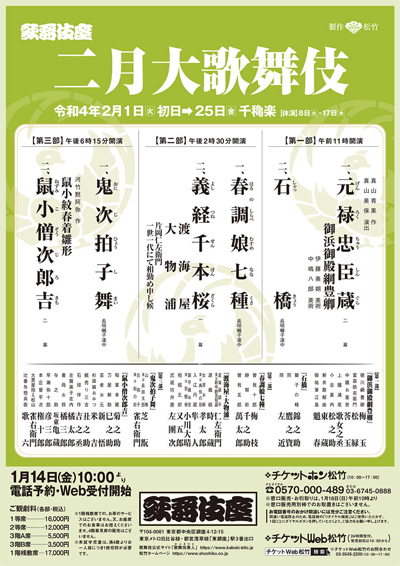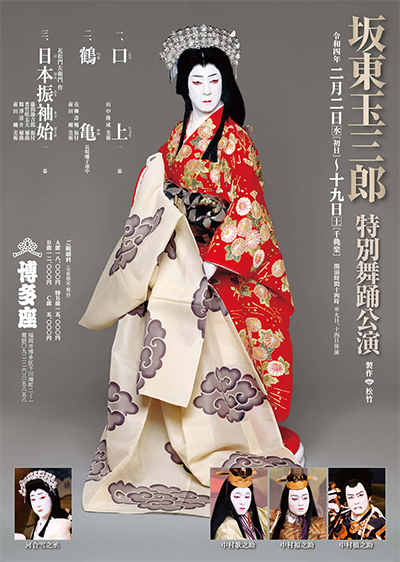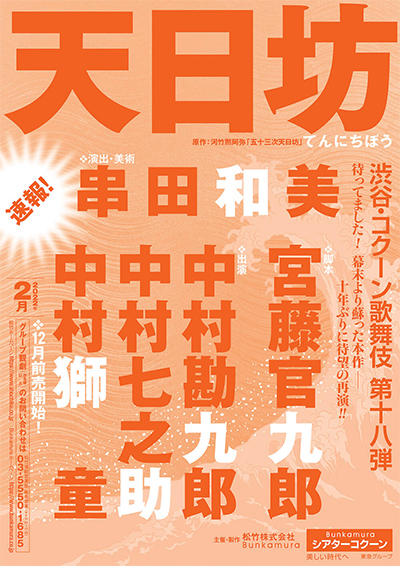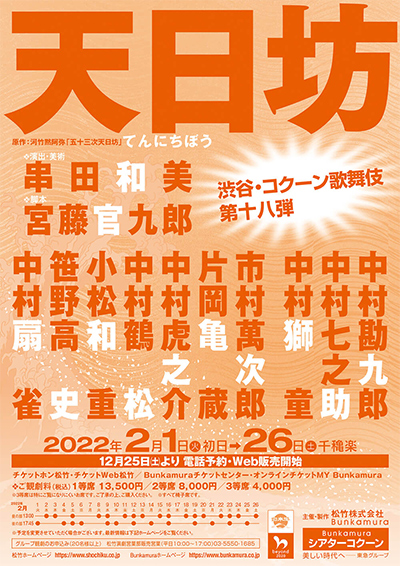| FEBRUARY 2022 |
| Postponement of one Kabuki program in February 2022 due to coronavirus (COVID-19)!!! |
|
5 shows in T˘ky˘ (Kabukiza, Theatre Cocoon, EX THEATER), 1 in Fukuoka (Hakataza) and
|
| Kabukiza (T˘ky˘) |  |
| Dates | 1 ~ 25 February 2022 Nigatsu ďkabuki February Grand Kabuki |
| 1st program | |
| 2nd program |
Haru no Shirabe Musume Nanakusa
|
| 3rd program | |
| Casting |
Living National Treasure Kataoka Nizaemon, Living National Treasure Nakamura T˘z˘, Nakamura Shikan, Nakamura Jakuemon, Nakamura Baigyoku, Nakamura Kaishun, Nakamura Tokiz˘, Nakamura Kinnosuke, Kataoka Takatar˘, Onoe Sh˘roku, Ichikawa Sadanji, Band˘ Hikosabur˘, Band˘ Kamez˘, Nakamura Karoku, Nakamura Matagor˘, Nakamura Baishi, Nakamura Hayato, Band˘ Minosuke, Nakamura Yonekichi, Band˘ Shingo, Nakamura Kangyoku, Kawarasaki Gonjűr˘, Nakamura Kamenoj˘, Nakamura Mantar˘, Arashi Kitsusabur˘, Kataoka Matsunosuke, Ichimura Kitsutar˘, Nakamura Kichinoj˘, Kataoka Sennosuke, Nakamura Takanosuke, Onoe Sakon, Onoe Ushinosuke |
| Comments |
The February Grand Kabuki at the Kabukiza. Living National Treasure Kataoka Nizaemon does his isse ichidai performance for the role of the Heike warrior Taira no Tomomori in "Tokaiya"/"Daimotsu no Ura". Due to people infected with coronavirus, cancellation of the third program from the 14th to the 19th of February 2022.
|
 |
|
|||
| Dates | 2 ~ 19 February 2022 Band˘ Tamasabur˘ Tokubetsu Buy˘ K˘en Band˘ Tamasabur˘ Special Dance Performances |
||
| Program | |||
| Casting |
Living National Treasure Band˘ Tamasabur˘, Nakamura Hashinosuke, Nakamura Fukunosuke, Nakamura Utanosuke, Kawai Yukinoj˘ |
||
| Comments |
A special Buy˘ program in Fukuoka at the Hakataza starring Living National Treasure Band˘ Tamasabur˘.
|
||
 |
|
|||
| Dates | 1 ~ 24 |
||
| Program |
Tennichib˘ |
||
| Casting |
Nakamura Kankur˘, Nakamura Shichinosuke, Nakamura Shid˘, Nakamura Senjaku, Kataoka Kamez˘, Ichimura Manjir˘, Nakamura Tsurumatsu, Nakamura Toranosuke, Komatsu Kazushige, Sasano Takashi |
||
| Comments |
18th edition of the original Cocoon Kabuki performance, which recreates the atmosphere of the Edo koshibai and brings the actors closer to the audience. The play "Tennichib˘" was written by Kud˘ Kankur˘, based on Kawatake Mokuami's masterpiece "Ten'ichib˘", and is directed by Kushida Kazuyoshi. It was staged for the first time in the 2012 Cocoon Kabuki. Cancellation of the Cocoon Kabuki performances the 25th and the 26th of February 2022 due to the illness of a member of staff.
|
||
 |
 |
 |
| EX THEATER (T˘ky˘) |  |
| Dates | 18 February ~ 6 March 2022 (Roppongi Kabuki) Roppongi Kabuki |
| Program |
Hanazochiru |
| Casting |
Ichikawa Ebiz˘, Ichikawa Udanji, Nakamura Kotar˘, Totsuka Sh˘ta |
| Comments |
Fourth edition of the Roppongi Kabuki performances at the EX THEATER. Based on a script written by Imai Toyoshige, the stage direction is done by the famous movie director Miike Takashi, an expert in violent and bizarre movies who worked twice with Ichikawa Ebiz˘ for the movies "Hara-Kiri: Death of a Samurai" (2011) and "Over your Dead Body" (2014). "Hanazochiru" is based on Kawatake Mokuami's drama "Benten Koz˘" but it has been reformatted in order to fit in a new background reminiscent of the current times and to attract younger audiences. |
 |
| ďtsuka Museum of Art (Naruto) |
| Dates | Sistine Kabuki |
| Program |
??? |
| Casting |
??? |
| Comments |
The 11th edition of the Sistine Kabuki, a Kabuki program within the Sistine Hall of the ďtsuka Museum of Art, which is located in the city of Naruto (Tokushima prefecture), has been postponed due to the COVID-19 crisis. |
|
|
| Contact | Main | Top | Updates | Actors | Plays | Playwrights | Programs | Links | FAQ | Glossary | Chronology | Illustrations | Prints | Characters | Derivatives | Theaters | Coming soon | News |

